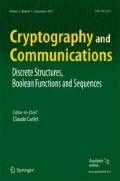Abstract
Orthogonal multi-arrays were first formulated by Brickell in investigation of authentication codes. In this article, we will prove that t-fold perfect splitting authentication codes with equal deception probabilities can be characterized in terms of orthogonal multi-arrays. We will also investigate the existence of orthogonal multi-arrays, and show that the existence of orthogonal multi-arrays OMA (t,k×c,n)s is equivalent to the existence of transversal splitting t-designs splitting TD (t,k×c,n)s. Further, we obtain some new infinite classes of t-fold perfect splitting authentication codes with equal deception probabilities.
Similar content being viewed by others
References
Abel, R.J.R.: Existence of five MOLS of order 18 and 60. J. Combin. Designs. doi:10.1002/jcd.21384
Abel, R.J.R., Colbourn, C.J., Dinitz, J.H.: Mutually Orthogonal Latin Squares (MOLS). In: Colbourn, C.J., Dinitz, J.H., Dinitz, J.H. (eds.) The CRC Handbook, pp. 160–192. CRC Press, Boca Raton (2007)
Brickell, E.F.: A few results in message authentication. Congr. Numer. 43, 141–154 (1984)
Bush, K.A.: Orthogonal arrays of index unity. Ann. Math. Stat. 23, 293–295 (1952)
Chee, Y.M., Zhang, X., Zhang, H.: Infinite families of optimal authentication codes secure against spoofing attacks of highter order. Adv. Math. Commun. 5, 59–68 (2011)
Huber, M.: Combinatorial bounds and characterizations of splitting authentication codes. Crypt. Commun. 2, 173–185 (2010)
Ji, L., Yin, J.: Constructions of new orthogonal arrays and covering arrays of strength three. J. Combin. Theory, Ser. A 117, 23–33 (2010)
Liang, M.: Combinatorial Constructions for Authentication Codes. PhD thesis, Suzhou University (2012)
Liang, M., Du, B.A: new class of splitting 3-designs. Des. Codes Crypt. 60, 283–290 (2011)
Liang, M., Du, B.A: new class of 3-fold perfect splitting authentication codes. Des. Codes Crypt. 62, 109–119 (2012)
Mills, W.H.: On the existence of H designs. Congr. Numer. 79, 129–141 (1990)
Pei, D.: Information-theoretic bounds for authentication codes and block designs. J. Crypt. 8, 177–188 (1995)
Pei, D.: Authentication Codes and Combinatorial Designs. ChapmanHall/CRC, Boca Raton (2006)
Simmons, G.J.: A game theory model of digital message authentication. Congr. Numer. 34, 413–424 (1982)
Todorov, D.T.: Four Mutually Orthogonal Latin Squares of order 14. J. Combin. Designs 22, 363–364 (2012)
Acknowledgments
This work was supported by the National Natural Science Foundation of China (Grant No. 11171248, 11301370).
Author information
Authors and Affiliations
Corresponding author
Rights and permissions
About this article
Cite this article
Li, M., Liang, M. & Du, B. A construction of t-fold perfect splitting authentication codes with equal deception probabilities. Cryptogr. Commun. 7, 207–215 (2015). https://doi.org/10.1007/s12095-014-0107-4
Received:
Accepted:
Published:
Issue Date:
DOI: https://doi.org/10.1007/s12095-014-0107-4


